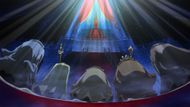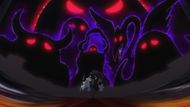One Piece has always been praised for its vast world-building and complex mysteries, with the mystifying character of Imu at the center of numerous unresolved questions. Since the introduction of the character as the secretive leader of the world, fans have extensively theorized about their identity, power, and significance as well as influence within history. Another controversial aspect of Imu's identity that remains unsettled is gender, which was purposely left unclear by the creator Eiichiro Oda. But one can draw a conclusion by observing the cultural subtleties of Japanese honorifics.
Upon careful inspection, one will realize that One Piece has been implicitly affirming the gender of Imu by referring to them with the title Imu-sei. This difference is not accidental, since the series has appropriately utilized honorifics and titles, which conform to the Japanese culture. Male saints are referred to with the suffix -聖 (sei), whereas female saints are referred to with -宮 (guu). There is a strong indication that Imu is male because of the use of -sei to denote them instead of -guu. Even this minor but significant linguistic decision points to the fact that Oda is cognizant of the cultural accuracy within the series, and sometimes leaves crumbs of details for the sharp-eyed readers.

This point can be further elaborated by observing the pre-established precedents in One Piece. Female saints, including Sharly and Gunko, are directly referred to with -guu, and their gender is made obvious through their names. In contrast, -sei has never been used to refer to female characters. Therefore, it is too much of a coincidence and leaves little room for ambiguity when Imu is constantly called Imu-sei. It is a continuation of the cultural system Oda has adhered to within the story.
One Piece and the Cultural Nuance Behind Imu’s Gender
To comprehend the importance of this detail, it is necessary to first recognize that Oda uses the cultural references in One Piece meticulously. The honorifics and titles are not randomly selected but are a part of the centuries-old Japanese linguistic tradition. Sufix -聖 (sei) is indicative of saintly respect that has historical links within the male form. In comparison, -宮 (guu) has a female connotation to refer to female saints or priestesses. This difference allows readers and viewers to immediately identify the gender of the characters who were referred to by such titles.
Gender is, in this instance, supported by consistency with these norms. In the case of Sharly, for instance, the title -guu is retained, as per her status as a woman. Similar is the case with Gunko, who substantiates the tradition. Imu, however, discontinues the ambiguity that has shrouded their appearance and aura by being referred to with -sei. The use of -sei demonstrates a faint yet conscious validation.

In addition to the mechanics of titles, the choice is thematic in One Piece. Imu overshadows the Gorosei and controls the world government, representing absolute power and secretiveness. Giving Imu the suffix -sei not only makes linguistic sense but reinforces the character to conform to traditionally masculine tropes of shadow rulers and patriarchal power. In that way, language usage is consistent with the role that Imu plays in the story.
The gender discussion of Imu has also been supported by the androgynous design of the character. Oda does not want to emphasize traditionally masculine or female qualities in the appearance of Imu, and it remains a mystery. The cultural hint in the title, however, circumvents the visual ambiguity. It represents a more subtle way of confirming fan theories without spoiling the mystery of the character. To a large extent, the method enables fans to assemble the truth, yet retain Imu cloaked in narrative mystery.

It is also noteworthy that One Piece has never been afraid of using the cultural richness to enliven its narration. Be it in citing world myths, historical characters, or Japanese culture, Oda incorporates reality into the world. The affirmation of Imu as a male by the -sei suffix aligns with this larger creative approach. It is not as much about making the fact obvious but more rewarding to those who listen and concentrate, even on the minor aspects of language.

Interpreting these details, fans can come to the conclusion that Oda has already answered one of the major questions about Imu. The ambiguity of the visual can be left to interpretation, but the text is strongly indicative of the view that Imu is male. This does not reduce the mystery but rather adds another layer that audiences can unravel even before the entire revelation is offered in later chapters.
To conclude, the use of saintly titles in the culture of One Piece might have implicitly validated the gender of Imu. The regular use of -聖 (sei) with males and -宮 (guu) with females makes little doubt of Oda’s intentions. Since Sharly and Gunko have already strengthened the tradition, the title of Imu-sei cannot be disregarded. It implies that Imu is male, which ends a long-running controversy, though it still creates narrative tension. This cautious mixing of culture and narrative shows how Oda excels in imbuing his details with little truths so that One Piece remains multi-layered and gratifying as ever.
